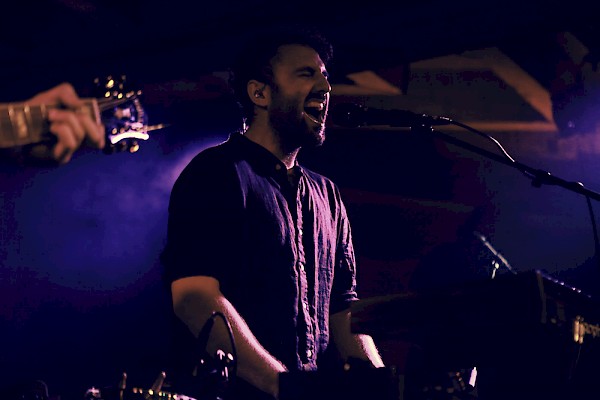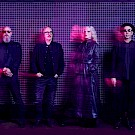 Local Natives at the Doug Fir Lounge on June 21—click to see more photos by Sarah Midkiff“These are 12 songs that all of us wholeheartedly thought, ‘This is the best we can do,’” shares Local Natives’ guitarist and vocalist Kelcey Ayer. What began as a friendship in high school between founding members Taylor Rice, Ryan Hahn and Ayer has grown into international tours, festival performances, and two well-received albums: Gorilla Manor in 2009 and Hummingbird in 2013. The L.A.-based indie rock band bring back their skillful songwriting and youthful sound as they tour leading up to their forthcoming album Sunlit Youth.
Local Natives at the Doug Fir Lounge on June 21—click to see more photos by Sarah Midkiff“These are 12 songs that all of us wholeheartedly thought, ‘This is the best we can do,’” shares Local Natives’ guitarist and vocalist Kelcey Ayer. What began as a friendship in high school between founding members Taylor Rice, Ryan Hahn and Ayer has grown into international tours, festival performances, and two well-received albums: Gorilla Manor in 2009 and Hummingbird in 2013. The L.A.-based indie rock band bring back their skillful songwriting and youthful sound as they tour leading up to their forthcoming album Sunlit Youth.
Settling into one of the open seating areas at the Jupiter Hotel, Ayer and his co-founding bandmate, Rice, delve into their songwriting process, the locations that impacted their new album, and how routine can be the bane of creativity—all before soundcheck at the Doug Fir Lounge on June 21.
“We worked through so many songs for this record that this record, I think more so than the other two, everyone feels really amazing because it went through such a process,” comments Ayers on the creation of their third album.
You guys are set to release your latest album, Sunlit Youth, on September 9. Would you say the singles are a good indicator of the album?
Taylor Rice: The two singles that are out? Umm, I feel like those two could be seen as representative of the album overall.
Kelcey Ayer: We’re all really pumped on this record. Every song has its own kind of world, but there are similarities and through lines. “Villainy” definitely shows us trying to really embrace the kind of music we’ve been listening to, which is a lot of electronic music and electropop music. In that respect, there is a lot of that feeling throughout the album but in different ways.
TR: I think “Past Lives” [listen below] is showing the rock band that is still within us. But there are still a few other random surprises that were even kind of surprising for us that don’t have any relation to those songs.
Gorilla Manor was recorded in L.A. and Hummingbird in Brooklyn. Where was Sunlit Youth written and recorded?
TR: Mostly L.A. L.A. has sort of become a prominent character almost throughout the album—a setting and a character. I think that’s because we went through this huge, long thing with Gorilla Manor, and all the craziness that happened with that went straight into Hummingbird, [and then we] toured that nonstop. Over the last two years now, it’s really been the first time in about six years that we got to be home and put down roots, becoming adults and having that life. L.A. was this really amazing environment for us to do that, and to get off of the treadmill. It’s an awesome treadmill, very fun, but nonetheless it is one. We got to take this exhale and decide, “What do I actually want to do?”
KA: I think a part of that feeling [was] like we’re free, feeling inspired. We got the opportunity to record in Thailand for a couple weeks at the end of 2014. That kind of started the writing of the record. We wrote and recorded for about a year and a half. We went to Thailand, that was a really crazy place to be. Such an insanely beautiful place to work on the album and to play music everyday.
We went to Nicaragua last year. Through a friend, we got this deal for this place that felt like a hotel but was kind of like a hostel in that there is a community of people wanting to get out of their busy lives and go somewhere super different. They had a little studio there that we kind of took over. That was an insane experience. Taking trips out of L.A. all over the place. We tried to not bog ourselves down by staying in any one spot. We’d just take our rig and rent a house in Ojai or in Joshua Tree for a week.
TR: So I think the shorter answer is: L.A. is our home and where most of the writing was done, most of the recording. But there were also these little trips that we would take to break out of our normal environment and open things up. We have songs like “Past Lives” that was recorded in Thailand, Ojai, L.A. and a couple of studios. The songs have these imprints of a lot of different parts of the world on them.
You’ve kind of touched on it already, but how do you think the approach of this album is different than the previous two?
TR: It changed sort of a lot for us. It was a gradual process. I think we just wanted to open up. The theme of the album, for us, was to feel really free to experiment and to do what felt right. Early on we were just jamming in the room together, which is kind of mostly all how Gorilla Manor was done, and most of Hummingbird was done. We’d had that desire, and it was fun, but it felt like a thing that we had done before. And so we branched out of that.
Kelcey, Ryan and myself are all three songwriters and singers in the band. We all got much better at producing songs on our own and going off and fully producing ourselves on our computers. We followed that thread. The way that writing happened was that we would work alone for a while, produce tunes, and then work on them together in a small group before bringing it to the band. The result of that was way, way more creative output and a huge proliferation. The theme was just follow it if it seems fun and exciting. We wrote triple the amount of songs than we had for either of the previous two albums.
 Local Natives at the Doug Fir Lounge on June 21—click to see more photos by Sarah MidkiffThat must be such good feedback for trying a new approach. You can get into similar routines, and routines can often be the bane of creativity.
Local Natives at the Doug Fir Lounge on June 21—click to see more photos by Sarah MidkiffThat must be such good feedback for trying a new approach. You can get into similar routines, and routines can often be the bane of creativity.
TR: Exactly.
KA: We had hit walls on other records where we would struggle to write a song over the course of eight months and keep coming back to it, and keep coming back to it. This time, as soon as it wasn’t flowing or feeling good, we would just switch. Now, just being older, this being the third record now, I mean we haven’t made millions of records, but more than one now. I think we felt a lot more confident this time around just knowing that if a song is really good and meant to be somewhere then it’s going to come back. That happened with quite a few songs. We would put them aside, change something else, and they would just reappear in a new way. It felt like pressurized.
TR: And the Hummingbird period was really, really hard and had a lot of darkness in it. The album was really cathartic and felt really good, but it was difficult. This was much more just following a spark of joy and having fun with it.
So you guys collaborate quite a bit. What do you do if you don’t agree on something?
TR: Just a dance battle.
There you go! That’s how all disputes should be settled.
TR: Or arm wrestle.
KA: It’s nice to have five people in a band because we’ll always have a tiebreaker. It’s a struggle, but I think the tension is really good and it pushes people to think of things in a different way. Like Ryan and Taylor, there was a point where they came to the table with, I think Ryan had the seed of “Villainy” [watch the lyric video below] and then Taylor had brought “Sea of Years,” which is a song on the record that you’ll hear later. I was so impressed and I didn’t have anything nearly as good so it really pushed me to do something. We end up pushing each other when we disagree on something. Really, for a Local Natives song to exist and to come out onto a record that people hear, it’s usually the ones that everyone is the most excited about.
And I think that comes across in music. You can tell when an artist really enjoys what they’re doing or what they wrote. You can hear it.
KA: We were in such a positive spot. If that is the thing that comes across on the record then that would be awesome.







